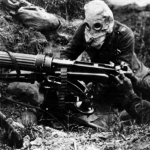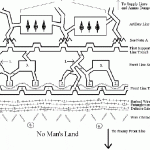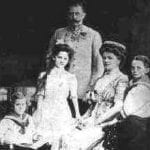
The following post is by guest contributor Ian McCall.
In the story of WW1, the campaigns in Africa tend to be overlooked, and even those who have a familiarity with the war tend to be unaware of the battles fought south of Mesopotamia. This is because almost all these military campaigns involved native colonial forces backed up by a small number of regular army troops and usually ended with a swift and decisive victory in favor of the Entente. The British, French, and Belgians simply had too many colonies and too many forces in Africa for the Germans to put up much of a fight- with one exception. In German East Africa a guerrilla war would be fought like nothing else the war would see. This guerrilla action was fought by a force of well-trained Askaris, native troops, and regular German infantry numbering about 12,000 at the onset of the war. This relatively small garrison would, throughout the war, tie-down over 300,000 Entente troops coasting the collation over 10,000 killed.1 These forces would even continue the fight after the armistice had been signed and the war officially ended. This was all thanks to the actions of one man, Paul von Lettow-Vorbeck. Called the loin of Africa, Lettow-Vorbeck would lead his troops on a campaign that would go down as one of the most successful of WW1 and earn him a place as a hero to the German people.
When World War I started, German East Africa was much like much of colonial Africa. The German empire had ruled the area that would one day become Rwanda, Burundi, and continental Tanzania since 1885 and took control of the resources that were found there such as rubber, coffee, and gold.2 However, it would be the introduction of sisal from Florida, a plant whose fibers were important in the production of low-cost twine, that would prove to be the most economically important to the German economy.3 It was against this backdrop the first World War would start. With the German colonies in Western Africa falling fast to the combined Commonwealth and French forces, it seemed inevitable that German East Africa would fall soon as well. Most military commanders of the time would have opted for a defensive strategy, allowing the enemy forces to come to you to remain in a position of strength. This was the convention, but the commander of German forces in East Africa, Lieutenant Colonel Paul von Lettow-Vorbeck, was not one for convention. Knowing that he would be greatly outnumbered, Lettow-Vorbeck believed that the only way to win in the campaign was not to hold territory, but rather to keep the enemy occupied chasing ghosts, thus diverting enemy forces away from the war in Europe. To do this, he knew that striking first would get British attention. In August of 1914, he struck and dislodged two British positions around the base of Mount Kilimanjaro and Lake Victoria.4 Instead of holding these positions the German forces retreated into friendly territory and waited for the counterattack. The British would oblige and the battle that resulted would have the dubious honor of providing Lettow-Vorbeck’s forces with all the equipment that they could ever need to stage a successful guerrilla campaign.
British Major General Arthur Aitken would take the Indian expeditionary force onto boats and sail from Bombay. Assuming this would be another route, like other German colonies, General Aitken was not overly concerned with the ill-prepared state of his men or the poor intelligence he had about his landing zone at the port city of Tanga. And, even more foolishly, he allowed a naval officer to inform the local German forces of the British impeding plans to attack, believing that the garrison would surrender. This warning allowed Lettow-Vorbeck to reinforce his position and set up a defense.5 On October 2nd, a small force would try and land just east of the city but would be met with heavy machinegun fire and be forced to pull back. On the 4th, the real assault would begin as the Indian troops made a landing at the harbor. At first, the city seemed empty of both defenders and civilians. British forces had just begun to relax when the air was filled with bullets.5 Commonwealth troops faced an overwhelming hail of rifle and machine-gun fire, causing heavy casualties and plummeting their morale.5 In addition to the gunfire, Mother Nature seemed to be helping out the German forces as swarms of angry bees descended onto the battlefield, stinging so fiercely that at times the battle was put on hold to deal with the insects. As the British attack stalled, Lettow-Vorbeck launched a counterattack and pushed the invaders back onto their boats. The battle had been a disaster for the British as they suffered 1,000 casualties, compared with only 150 German losses.5 Additionally, in the chaos the British left behind hundreds of rifles and 12 machine guns, as well as over 850,000 rounds of ammunition. Lettow-Vorbeck now had everything he needed to start a guerrilla war. The battle of Tanga’s importance can’t be overstated in the context of the East Africa campaign.4 It gave the Germans a much-needed morale and supply boost and showed the British that they should not underestimate their opponent. One British officer would write after the battle “We lost 2 batteries, 12 maxims, 1 million rounds, rifles and goods galore… Unless something strange happens it will not be a walk over taking German East Africa.”6
The victory at Tanga may have been a major tactical victory, but the overall strategic situation favored the British. With the royal navy controlling the seas, the British were able to bring in more reinforcements. For most of 1915, the Germans were limited to small raids into Northern Rhodesia and Kenya.4 During this time the British continued to suffer casualties, if not from enemy rifle fire, then from the diseases that were rampant in the British camp. It is also important to consider the role of African porters, men who were conscripted into carrying supplies and equipment for both armies. Almost a million of these men would be pressed into service, many times this would prove to be a death sentence. The harsh conditions, combined with the heavy loads many were forced to carry, would lead to much higher casualties than both armies combined.7 But as 1915 was coming to an end, humanitarian issues were far from anyone’s mind. Lettow-Vorbeck’s raids had succeeded in holding the Allied attention, and they had yet to gain any German ground. But as 1916 dawned the British and their Belgian allies were determined to put an end to the Lion of Africa.
In March 1916, General Jan Smuts took command of allied forces and began a new offensive into German East Africa. With South African forces now free after the conquest of German Southwest Africa, the allies felt they were ready. Having fought against the British in the Boer War, Smuts believed he would be well equipped to deal with Lettow-Vorbeck. Sending his force in from Kenya in the north, Smuts was joined by Belgian forces coming from the west, and Rhodesia forces from the southwest.4 By August, the allied forces had managed to capture the main East African railway deep in German territory. However, this would have little effect on the German forces as they fought a running campaign falling back from the oncoming Allied forces. Compared with the other fronts of the war where a gain of half a mile could take months of slow progress, the campaign in East Africa was fought at lightning speed. With the armies covering up to 30 kilometers per day, Lettow-Vorbeck made great use of his army’s mobility to strike when the Allies least expected. One of the most important maxims of guerrilla warfare is picking your battles, and Lettow-Vorbeck excelled at this. Every time it seemed his forces would be surrounded and outmatched, they would melt back into the jungle. The Germans only struck when the surprise was on their side, and they conducted many successful ambushes of allied forces. Further slowing Allied progress was the mountainous terrain which allowed the Germans to leave behind small groups of men that could effectively slow down much larger forces. As 1916 dragged on the Allied forces began to suffer more casualties from German attacks and ever-present, and far more costly, diseases that wiped out whole units. One South African unit went into combat with 1,135 men in February and by October only 116 men remained. This unit had never seen combat but diseases such as malaria, tsetse fly, and black fever killed them far better than any German bullets could.7 At this point in the campaign for every man the Allies lost to combat, 30 more would fall to sickness.4 Lettow-Vorbeck knew this and took advantage of the immunity most of his forces had since they were either native of the region or had been stationed in East Africa for a while. To combat this advantage Smuts pulled out most of his South African and Indian troops and replaced them with African troops from all over the continent. By the end of the war, almost all the “British” forces would be made up of Africans, many of whom had never volunteered to be there.4
However well Lettow-Vorbeck had fought, he was still in a constant state of retreat, and by the end of 1916 German forces were confined to the south of the country. With a new British offensive starting in early 1917, Lettow-Vorbeck divided his forces into three groups to give each one a better chance to escape.4 While two of these groups were able to slip over the border into Portuguese-controlled Mozambique the third group was surrounded and forced to surrender. However, this group would not go down without a fight, with many of the men choosing to fight to the death. One British officer wrote of the German combat prowess, “The Germans seem to be a plucky lot. There was a white man on each maxim, and they were all bayoneted at their guns… The German Askari were Nubians of whom our men said were wonderful fighters.”8 The Portuguese colony was lightly defended, and the lack of resistance allowed the German forces to scavenge the supplies they needed from the countryside. This period known by the natives as the safari ya bwana lettow (the trek of Lettow-Vorbeck) was characterized by raids on local villages as well as Allied military forces.9 At this time German numbers began to dwindle as reinforcements were cut off. So, too, were basic supplies like food, medical, and ammo, forcing many Germans to use English weapons or risk running out of ammo. As time went on groups of Germans would give themselves up as the effects of the four-year campaign took their toll, but Lettow-Vorbeck would continue his guerrilla campaign and thus keep the allied forces occupied, unable to divert forces to other fronts. These raids would continue all the way into 1918, when, on November 25, a week after the war in Europe had ended, Lettow-Vorbeck received news from a British Prisoner that the armistice had been signed. Marching out of the juggle with his remaining forces- only 1,500 were left- Lettow-Vorbeck surrendered ending World War I in East Africa.4
The story of German East Africa has sadly been forgotten over the years. In the history of World War I, a guerrilla war in Africa seems a strange addition to long lines of trenches in the green fields of France. However, this campaign represents a master class in asymmetric warfare. The story of Paul von Lettow-Vorbeck deserves to be told and the bravery of his men remembered. Looking back, we can also see the German force did achieve its goal. Nearly 300,000 Allied forces were held in East Africa- no small feat for a force that numbered less than 20,000. In total 10,000 British soldiers would be killed while only 2,000 Germans would lose their lives. The cost to the native Africans was much higher, with almost 100,000 dying as porters or camp followers. Add to this the loss of many other civilians due to raiding and famine and you start to understand the true cost of this campaign.
1. Review of World War 1. n.d. Encyclopedia Britannica.
2.“Tanzania – German East Africa.” n.d. Encyclopedia Britannica.
3. German East Africa | Former German Dependency, Africa.” n.d. Encyclopedia Britannica.
4. East Africa Campaign | National Army Museum.” n.d.
5.“Battle of Tanga | Summary.” n.d. Encyclopedia Britannica.
6. Tanga. Letter to Sir Stanley De Burgh Edwardes. 1914, November 20, 1914.
7. Cole, Laura. n.d. “‘We May Never Know How Many Africans Died during WWI.’” Aljazeera
8. Wallace, Captain Alexander. Letter to His fiancée. 1916, September 13, 1916.
9. Pesek, Michael. n.d. Review of The German Empire at War in Eastern Africa, 1914-18. In Journal of First World War Studies.
Cite This Article
"German East Africa: The Forgotten WW1 Campaign" History on the Net© 2000-2024, Salem Media.
April 26, 2024 <https://www.historyonthenet.com/german-east-africa>
More Citation Information.








